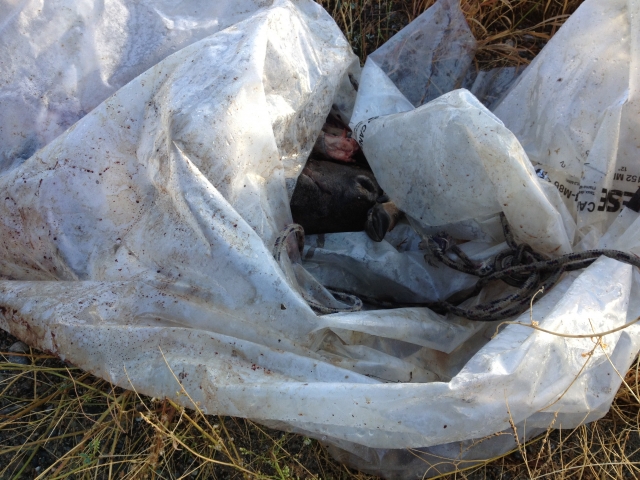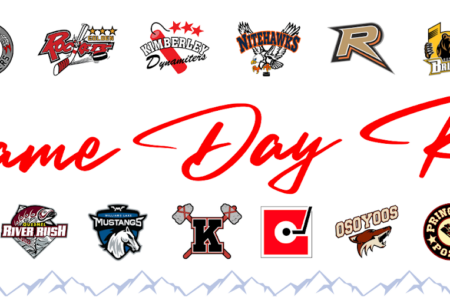Dead animals and other delights being dumped illegally down Boundary roads
Some might say it is laziness, others may want to blame it on the tipping fees at the dump or transfer station, but the reality is people like to dump their compostable lawn waste, old appliances and even animal carcasses down the roads less travelled in the Boundary.
Karen Mehmal, who operates a ranch and gravel quarry located on Highway 3 about four kilometers east of Grand Forks has had illegal dumping issues on her property for more than 20 years. The gravel pit is clearly marked, has fencing and cattle guards and is about the same distance from Grand Forks as the dump is up Granby Road. Yet people are still surprised when Mehmal catches them in the act of dumping on her private land.
“We have a huge problem with garbage dumping around our property,” said Mehmal, who estimates her and her husband remove several pick up loads of rubbish annually. “And not just on our private property, but on public and preserved land too. Everywhere seems to have a problem. They go anywhere they can – it’s amazing the trouble they go to to dump it in the bush … The whole garbage thing distresses us. There’s so much of it and we don’t know how to control it.”
Everything from old appliances and household garbage to cars and chestfields have made their way to her gravel pit and the bush beside a watering hole for her cattle.
“They are driving way out of the way to avoid dumping fees,” said Mehmal, who is in awe over the effort people will go to.
“It’s a pain to us when it is on our own property and we have to clean it up ourselves but they also dump on public land and in preserves,” she said, adding she’s seen dumping on Gilpin Forest Service Road and in and around the city water reservoir.
Bear carcasses are now becoming an increasingly disgusting issue on her property. This year she found two bears, one with the head removed and the other with the paws removed.
Those animal carcasses attract predators. Mehmal said while moving cattle in the Lost Lake area, not far from another popular dumping area, she saw a large black wolf not far from the Valley View subdivision.
“The wolf was a few hundred meters from the houses in Valley Heights and moments later a woman went jogging by with her dog and the wolf had run in her direction,” said Mehmal.
Boundary conservation officer Dave Webster shares Mehmal’s frustration.
“It is a chronic problem for us, especially at the Lake,” said Webster, referring to the deer carcass found dumped on Stewart Creek Road.
Dumping in high traffic areas creates a problem by attracting predators, making a smell and being unsightly. When it is wrapped in plastic it is then littering.
“Ideally hunters would take responsibility for their material by either depositing at the landfill or out in the woods were it is less visible.”
He said scavengers like crows, turkey vultures, eagles and coyotes will make quick work of cleaning up the carcass, as long as it is accessible to them and not wrapped in plastic or a tarp and without foreign articles like rubber gloves, which is an offense under Environmental Management Act.
To fee or not to fee, that is the question
Mehmal doesn’t feel the dump fees are unreasonable enough to take garbage into the wilderness.
However, she does see a direct correlation between the start of the fees and her problem more than 20 years ago.
“I think the regional district needs to reevaluate what they charge people for dumping,” said Mehmal.
I think there is a direct correlation between when they started charging people to dump and illegal dumping. As Canadians we are taxed to death and some people just resent the fact they’re being charged.
Tim Dueck, Regional District Kootenay Boundary solid waste program coordinator, said it wouldn’t matter if the tipping fees at the dump were free, people would still dump their refuse down country roads.
“There is no correlation between dumping it in the wilderness and tipping fees,” said Dueck. “People will dump in the wilderness even without tipping fees.”
He said in Trail there is an area at the edge of a creek where people have been dumping their garbage since the early 1900s. And it still happens today, even with all we collectively know about the environmental damage household waste can do to waterways.
“It’s a land ethic – how do you view your environment? People have to educate each other. People used to say things to their neighbours,” said Dueck, adding studies have shown that people who dump illegally have uncertain future incomes; they do it for convenience and use land they believe nobody is caring for.
While Mehmal feels that charging for dumping, the fencing off of the dump and stopping scavenging helped in creating the dumping problem on her property, she doesn’t feel the fees are unreasonable.
“There is no reason for people to dump garbage on private property when the dump fees are so cheap,” she said. “If they can afford to get new stuff, then paying the $20 fee to take (the used appliance) to the dump should be a problem. But it is a huge problem for us and there is a cost to us to remove it.”
“I don’t know if (RDKB) removed the charge that people would stop dumping, but it definitely would be something to talk about,” said Mehmal.
Dueck also suggests talking would help, but not governmental discussions.
Peer pressure and not government law enforcement would help. By telling your buddies not to throw that beer can into the bush you can help stop illegal dumping. It all starts with a beer can.
While dumping is illegal, it is hard to catch people in the act.
Sadly, the only way Webster, as a conservation officer who covers a vast region alone, can catch the culprits is if someone sees them do it and records their license plate number or the person leaves incriminating evidence behind. The discharge of litter falls under the Wildlife Act.
Litterers can face as little as $115 fine for the dumping of domestic garbage to more than $600, depending on how much was dumped. More severe cases can be taken to court were fines of more than $100,000 can be enforced.
The basic fees
The RDKB takes a variety of things you might not know about.
You can take animal carcass in for safe disposal for a $20 fee.
Construction waste, another popular illegal dumping item, costs $50 a ton. The price is meant to encourage people to examine what they dump more closely.
While people can’t take things from the dump like they used to because of liability issues, Dueck suggests before dumping, take useful things like wood or other household items to second hand stores, Reuse centers or put a sign at the end of your driveway and give it away.
“Surely with that price there is some incentive to give away a useful 2×4,” he said. “There’s lots of stuff people want. A 2×6 could be burned and there are lots of uses for scrap lumber rather than putting it in the landfill.”
“People need to be responsible with their garbage, whether it is a deer carcass or lumber,” he said. “You take it into your home, then dispose of it responsibly. Don’t get sucked in by sales, because there is a lot of waste association with sales and food waste.”
Dueck said the average $3 bag of garbage represents $200 worth of purchased consumer goods.
For more information about dumping fees and hours of operation please visit www.rdkb.com.


























